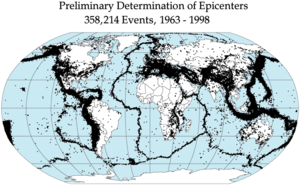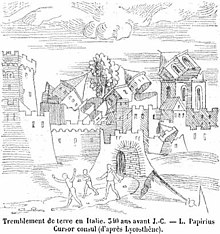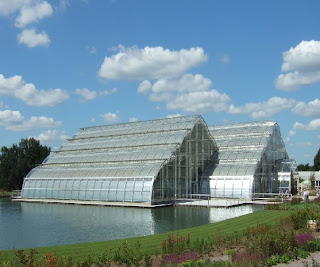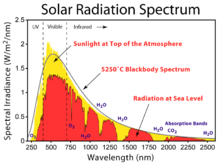An earthquake (also known as a quake, tremor or temblor) is the result of a sudden release of energy in the Earth's crust that creates seismic waves. The seismicity or seismic activity of an area refers to the frequency, type and size of earthquakes experienced over a period of time. Earthquakes are measured with a seismometer; a device which also records is known as a seismograph. The moment magnitude (or the related and mostly obsolete Richter magnitude) of an earthquake is conventionally reported, with magnitude 3 or lower earthquakes being mostly imperceptible and magnitude 7 causing serious damage over large areas. Intensity of shaking is measured on the modified Mercalli scale. The depth of the earthquake also matters: the more shallow the earthquake, the more damage to structures (all else being equal).
At the Earth's surface, earthquakes manifest themselves by shaking and sometimes displacing the ground. When a large earthquake epicenter is located offshore, the seabed sometimes suffers sufficient displacement to cause a tsunami. The shaking in earthquakes can also trigger landslides and occasionally volcanic activity.
In its most generic sense, the word earthquake is used to describe any seismic event—whether a natural phenomenon or an event caused by humans—that generates seismic waves. Earthquakes are caused mostly by rupture of geological faults, but also by volcanic activity, landslides, mine blasts, and nuclear tests. An earthquake's point of initial rupture is called its focus or hypocenter. The term epicenter refers to the point at ground level directly above the hypocenter.
Tectonic earthquakes will occur anywhere within the earth where there is sufficient stored elastic strain energy to drive fracture propagation along a fault plane. In the case of transform or convergent type plate boundaries, which form the largest fault surfaces on earth, they will move past each other smoothly and aseismically only if there are no irregularities or asperities along the boundary that increase the frictional resistance. Most boundaries do have such asperities and this leads to a form of stick-slip behaviour. Once the boundary has locked, continued relative motion between the plates leads to increasing stress and therefore, stored strain energy in the volume around the fault surface. This continues until the stress has risen sufficiently to break through the asperity, suddenly allowing sliding over the locked portion of the fault, releasing the stored energy. This energy is released as a combination of radiated elastic strain seismic waves, frictional heating of the fault surface, and cracking of the rock, thus causing an earthquake. This process of gradual build-up of strain and stress punctuated by occasional sudden earthquake failure is referred to as the Elastic-rebound theory. It is estimated that only 10 percent or less of an earthquake's total energy is radiated as seismic energy. Most of the earthquake's energy is used to power the earthquake fracture growth or is converted into heat generated by friction. Therefore, earthquakes lower the Earth's available elastic potential energy and raise its temperature, though these changes are negligible compared to the conductive and convective flow of heat out from the Earth's deep interior.
Earthquake fault types
There are three main types of fault that may cause an earthquake: normal, reverse (thrust) and strike-slip. Normal and reverse faulting are examples of dip-slip, where the displacement along the fault is in the direction of dip and movement on them involves a vertical component. Normal faults occur mainly in areas where the crust is being extended such as a divergent boundary. Reverse faults occur in areas where the crust is being shortened such as at a convergent boundary. Strike-slip faults are steep structures where the two sides of the fault slip horizontally past each other ; transform boundaries are a particular type of strike-slip fault. Many earthquakes are caused by movement on faults that have components of both dip-slip and strike-slip; this is known as oblique slip.
Earthquakes away from plate boundaries
Where plate boundaries occur within continental lithosphere, deformation is spread out over a much larger area than the plate boundary itself. In the case of the San Andreas fault continental transform, many earthquakes occur away from the plate boundary and are related to strains developed within the broader zone of deformation caused by major irregularities in the fault trace (e.g. the “Big bend” region). The Northridge earthquake was associated with movement on a blind thrust within such a zone. Another example is the strongly oblique convergent plate boundary between the Arabian and Eurasian plates where it runs through the northwestern part of the Zagros mountains. The deformation associated with this plate boundary is partitioned into nearly pure thrust sense movements perpendicular to the boundary over a wide zone to the southwest and nearly pure strike-slip motion along the Main Recent Fault close to the actual plate boundary itself. This is demonstrated by earthquake focal mechanisms.
All tectonic plates have internal stress fields caused by their interactions with neighbouring plates and sedimentary loading or unloading (e.g. deglaciation[4]). These stresses may be sufficient to cause failure along existing fault planes, giving rise to intraplate earthquakes.[5]
Shallow-focus and deep-focus earthquakes
The majority of tectonic earthquakes originate at the ring of fire in depths not exceeding tens of kilometers. Earthquakes occurring at a depth of less than 70 km are classified as 'shallow-focus' earthquakes, while those with a focal-depth between 70 and 300 km are commonly termed 'mid-focus' or 'intermediate-depth' earthquakes. In subduction zones, where older and colder oceanic crust descends beneath another tectonic plate, deep-focus earthquakes may occur at much greater depths (ranging from 300 up to 700 kilometers). These seismically active areas of subduction are known as Wadati-Benioff zones. Deep-focus earthquakes occur at a depth at which the subducted lithosphere should no longer be brittle, due to the high temperature and pressure. A possible mechanism for the generation of deep-focus earthquakes is faulting caused by olivine undergoing a phase transition into a spinel structure.
Earthquakes and volcanic activity
Earthquakes often occur in volcanic regions and are caused there, both by tectonic faults and the movement of magma in volcanoes. Such earthquakes can serve as an early warning of volcanic eruptions, as during the Mount St. Helens eruption of 1980.[8] Earthquake swarms can serve as markers for the location of the flowing magma throughout the volcanoes. These swarms can be recorded by seismometers and tiltmeters (a device which measures the ground slope) and used as sensors to predict imminent or upcoming eruptions.
Rupture dynamics
A tectonic earthquake begins by an initial rupture at a point on the fault surface, a process known as nucleation. The scale of the nucleation zone is uncertain, with some evidence, such as the rupture dimensions of the smallest earthquakes, suggesting that it is smaller than 100 m while other evidence, such as a slow component revealed by low-frequency spectra of some earthquakes, suggest that it is larger. The possibility that the nucleation involves some sort of preparation process is supported by the observation that about 40% of earthquakes are preceded by foreshocks. Once the rupture has initiated it begins to propagate along the fault surface. The mechanics of this process are poorly understood, partly because it is difficult to recreate the high sliding velocities in a laboratory. Also the effects of strong ground motion make it very difficult to record information close to a nucleation zone.
Rupture propagation is generally modelled using a fracture mechanics approach, likening the rupture to a propagating mixed mode shear crack. The rupture velocity is a function of the fracture energy in the volume around the crack tip, increasing with decreasing fracture energy. The velocity of rupture propagation is orders of magnitude faster than the displacement velocity across the fault. Earthquake ruptures typically propagate at velocities that are in the range 70–90 % of the S-wave velocity and this is independent of earthquake size. A small subset of earthquake ruptures appear to have propagated at speeds greater than the S-wave velocity. These supershear earthquakes have all been observed during large strike-slip events. The unusually wide zone of coseismic damage caused by the 2001 Kunlun earthquake has been attributed to the effects of the sonic boom developed in such earthquakes. Some earthquake ruptures travel at unusually low velocities and are referred to as slow earthquakes. A particularly dangerous form of slow earthquake is the tsunami earthquake, observed where the relatively low felt intensities, caused by the slow propagation speed of some great earthquakes, fail to alert the population of the neighbouring coast, as in the 1896 Meiji-Sanriku earthquake.
Earthquake clusters
Most earthquakes form part of a sequence, related to each other in terms of location and time. Most earthquake clusters consist of small tremors which cause little to no damage, but there is a theory that earthquakes can recur in a regular pattern.
Aftershocks
An aftershock is an earthquake that occurs after a previous earthquake, the mainshock. An aftershock is in the same region of the main shock but always of a smaller magnitude. If an aftershock is larger than the main shock, the aftershock is redesignated as the main shock and the original main shock is redesignated as a foreshock. Aftershocks are formed as the crust around the displaced fault plane adjusts to the effects of the main shock.
Earthquake swarms
Earthquake swarms are sequences of earthquakes striking in a specific area within a short period of time. They are different from earthquakes followed by a series of aftershocks by the fact that no single earthquake in the sequence is obviously the main shock, therefore none have notable higher magnitudes than the other. An example of an earthquake swarm is the 2004 activity at Yellowstone National Park.
Earthquake storms
Sometimes a series of earthquakes occur in a sort of earthquake storm, where the earthquakes strike a fault in clusters, each triggered by the shaking or stress redistribution of the previous earthquakes. Similar to aftershocks but on adjacent segments of fault, these storms occur over the course of years, and with some of the later earthquakes as damaging as the early ones. Such a pattern was observed in the sequence of about a dozen earthquakes that struck the North Anatolian Fault in Turkey in the 20th century and has been inferred for older anomalous clusters of large earthquakes in the Middle East.
Size and frequency of occurrence
There are around 500,000 earthquakes each year. About 100,000 of these can actually be felt. Minor earthquakes occur nearly constantly around the world in places like California and Alaska in the U.S., as well as in Guatemala. Chile, Peru, Indonesia, Iran, Pakistan, the Azores in Portugal, Turkey, New Zealand, Greece, Italy, and Japan, but earthquakes can occur almost anywhere, including New York City, London, and Australia. Larger earthquakes occur less frequently, the relationship being exponential; for example, roughly ten times as many earthquakes larger than magnitude 4 occur in a particular time period than earthquakes larger than magnitude 5. In the (low seismicity) United Kingdom, for example, it has been calculated that the average recurrences are: an earthquake of 3.7 - 4.6 every year, an earthquake of 4.7 - 5.5 every 10 years, and an earthquake of 5.6 or larger every 100 years. This is an example of the Gutenberg-Richter law.
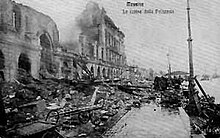
The number of seismic stations has increased from about 350 in 1931 to many thousands today. As a result, many more earthquakes are reported than in the past, but this is because of the vast improvement in instrumentation, rather than an increase in the number of earthquakes. The USGS estimates that, since 1900, there have been an average of 18 major earthquakes (magnitude 7.0-7.9) and one great earthquake (magnitude 8.0 or greater) per year, and that this average has been relatively stable. In recent years, the number of major earthquakes per year has decreased, although this is thought likely to be a statistical fluctuation rather than a systematic trend. More detailed statistics on the size and frequency of earthquakes is available from the USGS.
Most of the world's earthquakes (90%, and 81% of the largest) take place in the 40,000-km-long, horseshoe-shaped zone called the circum-Pacific seismic belt, known as the Pacific Ring of Fire, which for the most part bounds the Pacific Plate.[23][24] Massive earthquakes tend to occur along other plate boundaries, too, such as along the Himalayan Mountains.
With the rapid growth of mega-cities such as Mexico City, Tokyo and Tehran, in areas of high seismic risk, some seismologists are warning that a single quake may claim the lives of up to 3 million people.
Induced seismicity
While most earthquakes are caused by movement of the Earth's tectonic plates, human activity can also produce earthquakes. Four main activities contribute to this phenomenon: constructing large dams and buildings, drilling and injecting liquid into wells, and by coal mining and oil drilling. Perhaps the best known example is the 2008 Sichuan earthquake in China's Sichuan Province in May; this tremor resulted in 69,227 fatalities and is the 19th deadliest earthquake of all time. The Zipingpu Dam is believed to have fluctuated the pressure of the fault 1,650 feet (503 m) away; this pressure probably increased the power of the earthquake and accelerated the rate of movement for the fault. The greatest earthquake in Australia's history was also induced by humanity, through coal mining. The city of Newcastle was built over a large sector of coal mining areas. The earthquake was spawned from a fault which reactivated due to the millions of tonnes of rock removed in the mining process.
Measuring and locating earthquakes
Earthquakes can be recorded by seismometers up to great distances, because seismic waves travel through the whole Earth's interior. The absolute magnitude of a quake is conventionally reported by numbers on the Moment magnitude scale (formerly Richter scale, magnitude 7 causing serious damage over large areas), whereas the felt magnitude is reported using the modified Mercalli intensity scale (intensity II-XII).
Every tremor produces different types of seismic waves which travel through rock with different velocities: the longitudinal P-waves (shock- or pressure waves), the transverse S-waves (both body waves) and several surface waves (Rayleigh and Love waves). The propagation velocity of the seismic waves ranges from approx. 3 km/s up to 13 km/s, depending on the density and elasticity of the medium. In the Earth's interior the shock- or P waves travel much faster than the S waves (approx. relation 1.7 : 1). The differences in travel time from the epicentre to the observatory are a measure of the distance and can be used to image both sources of quakes and structures within the Earth. Also the depth of the hypocenter can be computed roughly.
In solid rock P-waves travel at about 6 to 7 km per second; the velocity increases within the deep mantle to ~13 km/s. The velocity of S-waves ranges from 2–3 km/s in light sediments and 4–5 km/s in the Earth's crust up to 7 km/s in the deep mantle. As a consequence, the first waves of a distant earth quake arrive at an observatory via the Earth's mantle.
Rule of thumb: On the average, the kilometer distance to the earthquake is the number of seconds between the P and S wave times 8. Slight deviations are caused by inhomogeneities of subsurface structure. By such analyses of seismograms the Earth's core was located in 1913 by Beno Gutenberg.
Earthquakes are not only categorized by their magnitude but also by the place where they occur. The world is divided into 754 Flinn-Engdahl regions (F-E regions), which are based on political and geographical boundaries as well as seismic activity. More active zones are divided into smaller F-E regions whereas less active zones belong to larger F-E regions.
Effects/impacts of earthquakes

The effects of earthquakes include, but are not limited to, the following:
Shaking and ground rupture
Shaking and ground rupture are the main effects created by earthquakes, principally resulting in more or less severe damage to buildings and other rigid structures. The severity of the local effects depends on the complex combination of the earthquake magnitude, the distance from the epicenter, and the local geological and geomorphological conditions, which may amplify or reduce wave propagation. The ground-shaking is measured by ground acceleration.
Specific local geological, geomorphological, and geostructural features can induce high levels of shaking on the ground surface even from low-intensity earthquakes. This effect is called site or local amplification. It is principally due to the transfer of the seismic motion from hard deep soils to soft superficial soils and to effects of seismic energy focalization owing to typical geometrical setting of the deposits.
Ground rupture is a visible breaking and displacement of the Earth's surface along the trace of the fault, which may be of the order of several metres in the case of major earthquakes. Ground rupture is a major risk for large engineering structures such as dams, bridges and nuclear power stations and requires careful mapping of existing faults to identify any likely to break the ground surface within the life of the structure.
Landslides and avalanches
Earthquakes, along with severe storms, volcanic activity, coastal wave attack, and wildfires, can produce slope instability leading to landslides, a major geological hazard. Landslide danger may persist while emergency personnel are attempting rescue.
Fires

Earthquakes can cause fires by damaging electrical power or gas lines. In the event of water mains rupturing and a loss of pressure, it may also become difficult to stop the spread of a fire once it has started. For example, more deaths in the 1906 San Francisco earthquake were caused by fire than by the earthquake itself.
Soil liquefaction
Soil liquefaction occurs when, because of the shaking, water-saturated granular material (such as sand) temporarily loses its strength and transforms from a solid to a liquid. Soil liquefaction may cause rigid structures, like buildings and bridges, to tilt or sink into the liquefied deposits. This can be a devastating effect of earthquakes. For example, in the 1964 Alaska earthquake, soil liquefaction caused many buildings to sink into the ground, eventually collapsing upon themselves.
Human impacts

Earthquakes may lead to disease, lack of basic necessities, loss of life, higher insurance premiums, general property damage, road and bridge damage, and collapse or destabilization (potentially leading to future collapse) of buildings. Earthquakes can also precede volcanic eruptions, which cause further problems; for example, substantial crop damage, as in the "Year Without a Summer" (1816).
Major earthquakes
The largest earthquake that has been measured on a seismograph reached 9.5 magnitude, occurring on 22 May 1960. Its epicenter was near Cañete, Chile. The energy released was approximately twice that of the next most powerful earthquake, the Good Friday Earthquake, which was centered in Prince William Sound, Alaska. The ten largest recorded earthquakes have all been megathrust earthquakes; however, of these ten, only the 2004 Indian Ocean earthquake is simultaneously one of the deadliest earthquakes in history.
The earthquakes with the greatest amount of loss of life, while powerful, were deadly because of their proximity to either heavily populated areas or the ocean, where earthquakes can potentially create tsunamis which can devastate communities thousands of miles away. Regions that are most at risk for great loss of life include those where earthquakes are relatively rare but powerful, and poor regions with lax, unenforced, or nonexistent seismic building codes.
Preparation
In order to determine the likelihood of future seismic activity, geologists and other scientists examine the rock of an area to determine if the rock appears to be "strained". Studying the faults of an area to study the buildup time it takes for the fault to build up stress sufficient for an earthquake also serves as an effective prediction technique. Measurements of the amount of accumulated strain energy on the fault each year, time passed since the last major temblor, and the energy and power of the last earthquake are made. Together the facts allow scientists to determine how much pressure it takes for the fault to generate an earthquake. Though this method is useful, it has only been implemented on California's San Andreas Fault.
Today, there are ways to protect and prepare possible sites of earthquakes from severe damage, through the following processes: earthquake engineering, earthquake preparedness, household seismic safety, seismic retrofit (including special fasteners, materials, and techniques), seismic hazard, mitigation of seismic motion, and earthquake prediction. Seismic retrofitting is the modification of existing structures to make them more resistant to seismic activity, ground motion, or soil failure due to earthquakes. With better understanding of seismic demand on structures and with our recent experiences with large earthquakes near urban centers, the need of seismic retrofitting is well acknowledged. Prior to the introduction of modern seismic codes in the late 1960s for developed countries (US, Japan etc.) and late 1970s for many other parts of the world (Turkey, China etc.), many structures were designed without adequate detailing and reinforcement for seismic protection. In view of the imminent problem, various research work has been carried out. Furthermore, state-of-the-art technical guidelines for seismic assessment, retrofit and rehabilitation have been published around the world - such as the ASCE-SEI 41 and the New Zealand Society for Earthquake Engineering (NZSEE)'s guidelines.
History
Pre-Middle Ages
From the lifetime of the Greek philosopher Anaxagoras in the 5th century BCE to the 14th century CE, earthquakes were usually attributed to "air (vapors) in the cavities of the Earth". Thales of Miletus, who lived from 625-547 (BCE) was the only documented person who believed that earthquakes were caused by tension between the earth and water. Other theories existed, including the Greek philosopher Anaxamines' (585-526 BCE) beliefs that short incline episodes of dryness and wetness caused seismic activity. The Greek philosopher Democritus (460-371BCE) blamed water in general for earthquakes. Pliny the Elder called earthquakes "underground thunderstorms".
Earthquakes in culture
Mythology and religion
In Norse mythology, earthquakes were explained as the violent struggling of the god Loki. When Loki, god of mischief and strife, murdered Baldr, god of beauty and light, he was punished by being bound in a cave with a poisonous serpent placed above his head dripping venom. Loki's wife Sigyn stood by him with a bowl to catch the poison, but whenever she had to empty the bowl the poison would drip on Loki's face, forcing him to jerk his head away and thrash against his bonds, causing the earth to tremble.
In Greek mythology, Poseidon was the cause and god of earthquakes. When he was in a bad mood, he would strike the ground with a trident, causing this and other calamities. He also used earthquakes to punish and inflict fear upon people as revenge.
In Japanese mythology, Namazu (鯰) is a giant catfish who causes earthquakes. Namazu lives in the mud beneath the earth, and is guarded by the god Kashima who restrains the fish with a stone. When Kashima lets his guard fall, Namazu thrashes about, causing violent earthquakes.
Popular culture
In modern popular culture, the portrayal of earthquakes is shaped by the memory of great cities laid waste, such as Kobe in 1995 or San Francisco in 1906.[53] Fictional earthquakes tend to strike suddenly and without warning. For this reason, stories about earthquakes generally begin with the disaster and focus on its immediate aftermath, as in Short Walk to Daylight (1972), The Ragged Edge (1968) or Aftershock: Earthquake in New York (1998). A notable example is Heinrich von Kleist's classic novella, The Earthquake in Chile, which describes the destruction of Santiago in 1647. Haruki Murakami's short fiction collection, After the Quake, depicts the consequences of the Kobe earthquake of 1995.
The most popular single earthquake in fiction is the hypothetical "Big One" expected of California's San Andreas Fault someday, as depicted in the novels Richter 10 (1996) and Goodbye California (1977) among other works. Jacob M. Appel's widely anthologized short story, A Comparative Seismology, features a con artist who convinces an elderly woman that an apocalyptic earthquake is imminent. In Pleasure Boating in Lituya Bay, one of the stories in Jim Shepard's Like You'd Understand, Anyway, the "Big One" leads to an even more devastating tsunami.
In the film 2012 (2009), solar flares (geologically implausibly) affecting the Earth's core caused massive destabilization of the Earth's crust layers. This created destruction planet-wide with earthquakes and tsunamis, foreseen by the Mayan culture and myth surrounding the last year noted in the Mesoamerican calendar - 2012.
Contemporary depictions of earthquakes in film are variable in the manner in which they reflect human psychological reactions to the actual trauma that can be caused to directly afflicted families and their loved ones. Disaster mental health response research emphasizes the need to be aware of the different roles of loss of family and key community members, loss of home and familiar surroundings, loss of essential supplies and services to maintain survival. Particularly for children, the clear availability of caregiving adults who are able to protect, nourish, and clothe them in the aftermath of the earthquake, and to help them make sense of what has befallen them has been shown to be even more important to their emotional and physical health than the simple giving of provisions. As was observed after other disasters involving destruction and loss of life and their media depictions, such as those of the 2001 World Trade Center Attacks or Hurricane Katrina—and has been recently observed in the 2010 Haiti Earthquake, it is also important not to pathologize the reactions to loss and displacement or disruption of governmental administration and services, but rather to validate these reactions, to support constructive problem-solving and reflection as to how one might improve the conditions of those affected.
